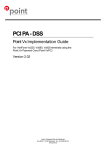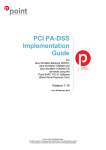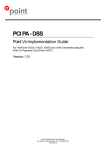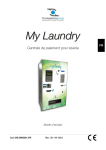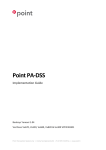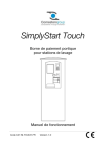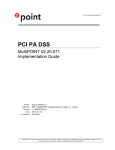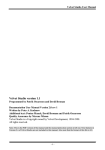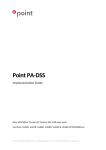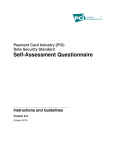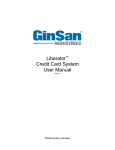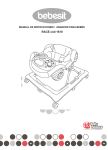Download Implementation Guide
Transcript
PCI PA - DSS Point BKX Implementation Guide Atos Xenta , Atos Xenteo and Atos Yomani using the Point BKX Payment Core Version 2.01 POINT TRANSACTION SYSTEMS AB Box 92031, 120 06 Stockholm, Tel. +46 8 566 287 00 www.point.se Version 2.01 Date 2011-10-19 Page number 2 (16) Revision History Version Name Date Comments 1.00 Mats Oscarsson 2011-03-25 Initial revision 1.01 Mats Oscarsson 2011-06-10 Front page changed to cover the Yomani 1.02 Mats Oscarsson 2011-06-13 Chapter 3.4: Added information that the TMS used for PED SW distribution should be checked by a QSA. Chapters 2.1 and 3.4: Added instruction not to place the terminal in an Internet accessible network zone (―DMZ‖). 2.01 Mats Oscarsson 2011-10-19 Updated for PCI PA-DSS version 2.0 Chapter ―3.3 Protect Wireless Transmissions‖ is updated. Chapter ―2.1 Build and Maintain a Secure Network, Requirement 1, c. What this means to you‖ is updated to describe the ports that need to be opened. Chapter ―2.5 Regularly Monitor and Test Networks, Requirement 10, c. What this means to you‖ is updated to contain information about how to change to address to the centralized log server‖ Copyright © 2011 POINT AB. All rights reserved. Copying and/or redistribution of this information in whole or in part without the express permission of Point Transaction Systems AB are prohibited. Version 2.01 Date 2011-10-19 Page number 3 (16) References Nbr. Title Version 1 2 Payment Card Industry – Payment Application Data Security Standard Payment Card Industry – Data Security Standard 2.0 2.0 Copyright © 2011 POINT AB. All rights reserved. Copying and/or redistribution of this information in whole or in part without the express permission of Point Transaction Systems AB are prohibited. Version 2.01 Date 2011-10-19 Page number 4 (16) Table of contents 1. Introduction ................................................................................................................................ 6 2. Summary of PCI DSS requirements ....................................................................................... 7 2.1 Build and Maintain a Secure Network .................................................................................... 7 Requirement 1: Install and maintain a firewall configuration to protect cardholder data ......... 7 a. b. c. What the requirement says................................................................................................................. 7 How your Point BKX helps you meet this requirement ..................................................................... 7 What this means to you ...................................................................................................................... 7 Requirement 2: Do not use vendor-supplied defaults for system passwords and other security parameters.............................................................................................................................................. 8 a. b. c. What the requirement says................................................................................................................. 8 How your Point BKX helps you meet this requirement ..................................................................... 8 What this means to you ...................................................................................................................... 8 2.2 Protect Cardholder Data........................................................................................................... 8 Requirement 3: Protect stored cardholder data............................................................................... 8 a. b. c. What the requirement says................................................................................................................. 8 How your Point BKX helps you meet this requirement ..................................................................... 8 What this means to you ...................................................................................................................... 8 Requirement 4: Encrypt transmission of cardholder data across open, public networks ....... 9 a. b. c. What the requirement says................................................................................................................. 9 How your Point BKX helps you meet this requirement ..................................................................... 9 What this means to you ...................................................................................................................... 9 2.3 Maintain a Vulnerability Management Program ................................................................... 9 Requirement 5: Use and regularly update anti-virus software or programs ............................... 9 a. b. c. What the requirement says................................................................................................................. 9 How your Point BKX helps you meet this requirement ..................................................................... 9 What this means to you ...................................................................................................................... 9 Requirement 6: Develop and maintain secure systems and applications ................................ 10 a. b. c. What the requirement says............................................................................................................... 10 How your Point BKX helps you meet this requirement ................................................................... 10 What this means to you .................................................................................................................... 10 2.4 Implement Strong Access Control Measures..................................................................... 10 Requirement 7: Restrict access to cardholder data by business need to know ...................... 10 a. b. c. What the requirement says............................................................................................................... 10 How your Point BKX helps you meet this requirement ................................................................... 10 What this means to you .................................................................................................................... 10 Requirement 8: Assign a unique ID to each person with computer access ............................. 11 a. b. c. What the requirement says............................................................................................................... 11 How your Point BKX helps you meet this requirement ................................................................... 11 What this means to you .................................................................................................................... 11 Requirement 9: Restrict physical access to cardholder data ...................................................... 11 a. b. c. What the requirement says............................................................................................................... 11 How your Point BKX helps you meet this requirement ................................................................... 11 What this means to you .................................................................................................................... 11 2.5 Regularly Monitor and Test Networks ................................................................................. 12 Requirement 10: Track and monitor all access to network resources and cardholder data . 12 a. b. c. What the requirement says............................................................................................................... 12 How your Point BKX helps you meet this requirement ................................................................... 12 What this means to you .................................................................................................................... 12 Requirement 11: Regularly test security systems and processes ............................................. 12 a. b. c. What the requirement says............................................................................................................... 12 How your Point BKX helps you meet this requirement ................................................................... 12 What this means to you .................................................................................................................... 12 2.6 Maintain an Information Security Policy.............................................................................. 13 Requirement 12: Maintain a policy that addresses information security for all personnel .... 13 Copyright © 2011 POINT AB. All rights reserved. Copying and/or redistribution of this information in whole or in part without the express permission of Point Transaction Systems AB are prohibited. Version 2.01 Date 2011-10-19 Page number 5 (16) a. What the requirement says ................................................................................................................... 13 b. How your Point BKX helps you meet this requirement ................................................................... 13 c. What this means to you .................................................................................................................... 13 3. How to set up your Point BKX to ensure PCI DSS compliance....................................... 14 3.1 3.2 3.3 3.4 3.5 Do not retain full magnetic stripe or card validation code ............................................... 14 Protect stored card holder data ............................................................................................ 14 Protect wireless transmissions............................................................................................. 15 Facilitate secure remote software updates ......................................................................... 15 Encrypt sensitive traffic over public networks ................................................................... 15 4. Terminology and abbreviations ............................................................................................ 16 Copyright © 2011 POINT AB. All rights reserved. Copying and/or redistribution of this information in whole or in part without the express permission of Point Transaction Systems AB are prohibited. 1. Version 2.01 Date 2011-10-19 Page number 6 (16) Introduction The Payment Card Industry Data Security Standard (PCI-DSS) defines a set of requirements for the configuration, operation, and security of payment card transactions in your business. If you use the Point BKX in your business to store, process, or transmit payment card information, this standard and this guide apply to you. The requirements are designed for use by assessors conducting onsite reviews and for merchants who must validate compliance with the PCI DSS. For more details about PCI DSS, please see the following link: http://www.pcisecuritystandards.org This guide is updated whenever there are changes in Point BKX software that affect PCI DSS and is also reviewed annually and updated as needed to reflect changes in the Point BKX as well as the PCI standards. You can download the latest version of this document from http://www.point.se/ The Payment Card Industry (PCI) has also set the requirements for software applications that store, process or transmit cardholder data. These requirements are defined by the Payment Card Industry Payment Application Data Security Standard (PCI PA-DSS). In order to facilitate for you to get a PCI DSS assessment the Point BKX Payment Core software has been validated by PCI to comply with the PCI PA-DSS requirements. Note: This guide refers to Point BKX terminals using the Point BKX Payment Core. The version of the Point BKX Payment Core is listed on the PCI web site “List of Validated Payment Applications” that have been validated in accordance with PCI PA-DSS. If you cannot find the version of the Point BKX Payment Core running on your Point BKX on that list please contact our helpdesk at Point in order to upgrade your terminal. http://www.pcisecuritystandards.org/ Document Use This PA-DSS Implementation Guide contains information for proper use of the Point BKX application. Point Transaction Systems AB does not possess the authority to state that a merchant may be deemed ―PCI DSS Compliant‖ if information contained within this document is followed. Each merchant is responsible for creating a PCI DSS-compliant environment. The purpose of this guide is to provide the information needed during installation and operation of the Point BKX application in a manner that will support a merchant’s PCI DSS compliance efforts. Note 1: Both the System Installer and the controlling merchant must read this document. Note 2: This document must also be used when training ECR integrators/resellers at initial workshops. Copyright © 2011 POINT AB. All rights reserved. Copying and/or redistribution of this information in whole or in part without the express permission of Point Transaction Systems AB are prohibited. 2. Version 2.01 Date 2011-10-19 Page number 7 (16) Summary of PCI DSS requirements This summary provides a basic overview of the PCI DSS requirements and how they apply to your business and the Point BKX terminal. 2.1 Build and Maintain a Secure Network Requirement 1: Install and maintain a firewall configuration to protect cardholder data a. What the requirement says ―Firewalls are devices that control computer traffic allowed between an entity’s networks (internal) and untrusted networks (external), as well as traffic into and out of more sensitive areas within an entity’s internal trusted networks. The cardholder data environment is an example of a more sensitive area within an entity’s trusted network. A firewall examines all network traffic and blocks those transmissions that do not meet the specified security criteria. All systems must be protected from unauthorized access from untrusted networks, whether entering the system via the Internet as e-commerce, employee Internet access through desktop browsers, employee e-mail access, dedicated connections such as business-to-business connections, via wireless networks, or via other sources. Often, seemingly insignificant paths to and from untrusted networks can provide unprotected pathways into key systems. Firewalls are a key protection mechanism for any computer network. Other system components may provide firewall functionality, provided they meet the minimum requirements for firewalls as provided in Requirement 1. Where other system components are used within the cardholder data environment to provide firewall functionality, these devices must be included within the scope and assessment of Requirement 1.‖, reference 2. b. How your Point BKX helps you meet this requirement Point BKX is designed to operate in a network behind a firewall. c. What this means to you If you are using wireless technology you must install and maintain a firewall to protect your Point BKX from someone hacking the wireless environment. Also, if your network connection allows inbound traffic you should use a firewall. The terminal should not be placed in an Internet accessible network zone (―DMZ‖). In case a firewall is connected between the terminal and the ECR/vending machine TCP port 2000 must be opened to enable communication between the two. For ports used for outbound traffic please refer to the information menu of the terminal. 1. Press the menu button on the terminal. 2. Enter password followed by the green button. 3. Select ‖3. INFORMATION‖ 4. Select ―3. HOST INFO‖ 5. Now, by scrolling with using the green button, the ports used for outbound traffic are shown in the display. For more information about setting up your firewall to work with Point BKX, please refer to the manual supplied by your firewall vendor. Copyright © 2011 POINT AB. All rights reserved. Copying and/or redistribution of this information in whole or in part without the express permission of Point Transaction Systems AB are prohibited. Version 2.01 Date 2011-10-19 Page number 8 (16) Requirement 2: Do not use vendor-supplied defaults for system passwords and other security parameters a. What the requirement says ―Malicious individuals (external and internal to an entity) often use vendor default passwords and other vendor default settings to compromise systems. These passwords and settings are well known by hacker communities and are easily determined via public information.‖, reference 2. b. How your Point BKX helps you meet this requirement Point BKX does not allow users to access any card holder data or sensitive authentication data. IP addresses for processors, terminal management systems and software download servers are protected by unique passwords per terminal and these passwords are changed on a daily basis. c. What this means to you Since the password protection for the Point BKX is handled entirely within the unit there is no need for you to take any action. 2.2 Protect Cardholder Data Requirement 3: Protect stored cardholder data a. What the requirement says ―Protection methods such as encryption, truncation, masking, and hashing are critical components of cardholder data protection. If an intruder circumvents other security controls and gains access to encrypted data, without the proper cryptographic keys, the data is unreadable and unusable to that person. Other effective methods of protecting stored data should be considered as potential risk mitigation opportunities. For example, methods for minimizing risk include not storing cardholder data unless absolutely necessary, truncating cardholder data if full PAN is not needed, and not sending unprotected PANs using end-user messaging technologies, such as e-mail and instant messaging. Please refer to the PCI DSS and PA-DSS Glossary of Terms, Abbreviations, and Acronyms for definitions of ―strong cryptography‖ and other PCI DSS terms.‖, reference 2. b. How your Point BKX helps you meet this requirement Point BKX never stores full magnetic stripe data from the card. For offline transactions PAN and expiry date are stored encrypted using a unique key per transaction At transaction time PAN is truncated before it is stored, only the first 6 and last 4 digits are stored. For printout of receipts and reports the truncated PAN is sent to the ECR. c. What this means to you For cards read by the Point BKX magnetic stripe reader or chip card reader you do not have to take any action. For manually entered PAN and for voice referrals it is never allowed to write down or otherwise store PAN, expiration date or CVV2. Copyright © 2011 POINT AB. All rights reserved. Copying and/or redistribution of this information in whole or in part without the express permission of Point Transaction Systems AB are prohibited. Version 2.01 Date 2011-10-19 Page number 9 (16) Requirement 4: Encrypt transmission of cardholder data across open, public networks a. What the requirement says ―Sensitive information must be encrypted during transmission over networks that are easily accessed by malicious individuals. Misconfigured wireless networks and vulnerabilities in legacy encryption and authentication protocols continue to be targets of malicious individuals who exploit these vulnerabilities to gain privileged access to cardholder data environments.‖, reference 2. b. How your Point BKX helps you meet this requirement The Point BKX encrypts card holder data using triple DES with a unique key per transaction. On top of that the entire messages sent to and from the Point BKX are protected using SSL, if the processor supports SSL. c. What this means to you If you are using a wireless network, WLAN, you must set up your wireless network to use WPA/WPA2 encryption for new installations. N.B. WEP must not be used after June 30 2010. The WLAN encryption is applied on top of the triple DES encryption and SSL (if SSL is supported by the processor) implemented in the terminal. If you connect to an external network without using WLAN you do not need to take any action. 2.3 Maintain a Vulnerability Management Program Requirement 5: Use and regularly update anti-virus software or programs a. What the requirement says ―Malicious software, commonly referred to as ―malware‖—including viruses, worms, and Trojans— enters the network during many business-approved activities including employee e-mail and use of the Internet, mobile computers, and storage devices, resulting in the exploitation of system vulnerabilities. Anti-virus software must be used on all systems commonly affected by malware to protect systems from current and evolving malicious software threats.‖, reference 2. b. How your Point BKX helps you meet this requirement The Point BKX cannot be used for e-mails or internet activities. All software downloaded to the terminal is controlled by Point, protected by a digital signature (MAC) and sent over an SSL connection (if the processor supports SSL). These security measures prevent malicious software being installed onto your Point BKX terminal. c. What this means to you You should install and maintain antivirus software which helps to protect your system. Make sure that this software is up to date as security threats change. For the Point BKX you do not need to take any action regarding antivirus software. Copyright © 2011 POINT AB. All rights reserved. Copying and/or redistribution of this information in whole or in part without the express permission of Point Transaction Systems AB are prohibited. Version 2.01 Date 2011-10-19 Page number 10 (16) Requirement 6: Develop and maintain secure systems and applications a. What the requirement says ―Unscrupulous individuals use security vulnerabilities to gain privileged access to systems. Many of these vulnerabilities are fixed by vendor-provided security patches, which must be installed by the entities that manage the systems. All critical systems must have the most recently released, appropriate software patches to protect against exploitation and compromise of cardholder data by malicious individuals and malicious software. Note: Appropriate software patches are those patches that have been evaluated and tested sufficiently to determine that the patches do not conflict with existing security configurations. For in-house developed applications, numerous vulnerabilities can be avoided by using standard system development processes and secure coding techniques.‖, reference 2. b. How your Point BKX helps you meet this requirement Point Transaction Systems constantly works with the latest security findings and requirements throughout the life cycle of your Point BKX. This includes automatic SW updates whenever necessary. c. What this means to you You should keep your system up to date with software updates, operating system updates, and any other security patches. For the Point BKX you do not need to take any action. 2.4 Implement Strong Access Control Measures Requirement 7: Restrict access to cardholder data by business need to know a. What the requirement says ―To ensure critical data can only be accessed by authorized personnel, systems and processes must be in place to limit access based on need to know and according to job responsibilities. ―Need to know― is when access rights are granted to only the least amount of data and privileges needed to perform a job.‖, reference 2. b. How your Point BKX helps you meet this requirement The Point BKX does not disclose any cardholder data. Sensitive authentication data is always encrypted when sent for authorization and never stored. PAN is always truncated when stored, thus only truncated PANs are sent to the ECR for printouts of reports, logs or receipts. c. What this means to you In case you need to enter card numbers manually or if you have to do voice referrals you must never keep written copies or otherwise store copies of cardholder data. Also, you must never e-mail, fax etc card holder data. For cards read by the Point BKX magnetic stripe reader or chip card reader you do not need to take any additional security measures. Copyright © 2011 POINT AB. All rights reserved. Copying and/or redistribution of this information in whole or in part without the express permission of Point Transaction Systems AB are prohibited. Version 2.01 Date 2011-10-19 Page number 11 (16) Requirement 8: Assign a unique ID to each person with computer access a. What the requirement says ―Assigning a unique identification (ID) to each person with access ensures that each individual is uniquely accountable for his or her actions. When such accountability is in place, actions taken on critical data and systems are performed by, and can be traced to, known and authorized users.‖, reference 2. b. How your Point BKX helps you meet this requirement The Point BKX does not allow access to critical data. c. What this means to you Since the Point BKX does not allow access to critical data you do not need to take any action. Requirement 9: Restrict physical access to cardholder data a. What the requirement says ―Any physical access to data or systems that house cardholder data provides the opportunity for individuals to access devices or data and to remove systems or hardcopies, and should be appropriately restricted. For the purposes of Requirement 9, ―onsite personnel‖ refers to full-time and part-time employees, temporary employees, contractors and consultants who are physically present on the entity’s premises. A ―visitor‖ refers to a vendor, guest of any onsite personnel, service workers, or anyone who needs to enter the facility for a short duration, usually not more than one day. ―Media‖ refers to all paper and electronic media containing cardholder data.‖, reference 2. b. How your Point BKX helps you meet this requirement The Point BKX physically prevents by encryption and truncation users to access cardholder data. c. What this means to you For your Point BKX you do not need to take any action. Copyright © 2011 POINT AB. All rights reserved. Copying and/or redistribution of this information in whole or in part without the express permission of Point Transaction Systems AB are prohibited. Version 2.01 Date 2011-10-19 Page number 12 (16) 2.5 Regularly Monitor and Test Networks Requirement 10: Track and monitor all access to network resources and cardholder data a. What the requirement says ―Logging mechanisms and the ability to track user activities are critical in preventing, detecting, or minimizing the impact of a data compromise. The presence of logs in all environments allows thorough tracking, alerting, and analysis when something does go wrong. Determining the cause of a compromise is very difficult, if not impossible, without system activity logs.‖, reference 2. b. How your Point BKX helps you meet this requirement The Point BKX keeps a log for the 1000 latest transactions. This log contains truncated PANs. No cardholder data is accessible from the Point BKX. The Point BKX also keeps an Audit Trail to track changes to system level objects. c. What this means to you For the transaction log you do not need to take any action since no cardholder data is accessible. For the Audit Trail there are no settings you need to do. The Audit Trail is created automatically and cannot be disabled. The Audit Trail could be sent manually to a centralized server by entering the Point BKX ―LOG MENU‖, for further details please refer to the user’s manual. The address to the centralized log server is already set when you receive the terminal and normally there is no need to change that address in the terminal. However, if for some reason this address needs to be changed please contact the representative of your service provider. Requirement 11: Regularly test security systems and processes a. What the requirement says ―Vulnerabilities are being discovered continually by malicious individuals and researchers, and being introduced by new software. System components, processes, and custom software should be tested frequently to ensure security controls continue to reflect a changing environment.‖, reference 2. b. How your Point BKX helps you meet this requirement Your Point BKX has mechanisms to ensure that software and parameters can be downloaded from trusted sources only. These mechanisms are based on cryptographic signatures and MAC protection (Message Authentication Code). c. What this means to you You should test your network connections (including wireless networks) periodically for vulnerabilities, and make use of network vulnerability scans. If you make any significant changes to your network, you should also test for vulnerabilities. Copyright © 2011 POINT AB. All rights reserved. Copying and/or redistribution of this information in whole or in part without the express permission of Point Transaction Systems AB are prohibited. Version 2.01 Date 2011-10-19 Page number 13 (16) 2.6 Maintain an Information Security Policy Requirement 12: Maintain a policy that addresses information security for all personnel a. What the requirement says ―All personnel should be aware of the sensitivity of data and their responsibilities for protecting it. For the purposes of Requirement 12, ―personnel‖ refers to full-time and part-time employees, temporary employees, contractors and consultants who are ―resident‖ on the entity’s site or otherwise have access to the cardholder data environment.‖, reference 2. b. How your Point BKX helps you meet this requirement ---c. What this means to you ---- Copyright © 2011 POINT AB. All rights reserved. Copying and/or redistribution of this information in whole or in part without the express permission of Point Transaction Systems AB are prohibited. 3. Version 2.01 Date 2011-10-19 Page number 14 (16) How to set up your Point BKX to ensure PCI DSS compliance 3.1 Do not retain full magnetic stripe or card validation code When upgrading the payment application in your Point BKX to comply with the PCI PA-DSS requirements this could be done two ways. 1. Your old unit is physically replaced by a new Point BKX loaded with software that complies with the PCI PA-DSS requirements. Since the old unit may contain historical magnetic stripe data, PANs, and CVV2s the unit must be returned to Point. 2. Your existing Point BKX is downloaded remotely with new software that complies with the PCI PA-DSS requirements. After download your Point BKX software is designed to remove all historical magnetic stripe data, PANs and CVV2s stored by previous versions of the software. In both cases you must make sure that the software version of the Point BKX Payment Core that runs on your Point BKX is listed on the PCI web site ―List of Validated Payment Applications‖ that have been validated in accordance with PCI PA-DSS. http://www.pcisecuritystandards.org In order for your organization to comply with PCI DSS requirements it is absolutely necessary to remove historical data stored prior to installing your PCI PA-DSS compliant Point BKX terminal. Therefore you must make sure that historical data (magnetic stripe data, cardholder data and CVV2s) are removed from all storage devices used in your system, ECRs, PCs, servers etc. For further details please refer to your vendor. No specific setup of your Point BKX PCI PA-DSS compliant terminal is required. PAN is stored either truncated or encrypted. Full magnetic stripe data and CVV2 is deleted immediately after authorization and never stored. However, if you need to enter PAN, expiration date and CVV2 manually or do a voice referral you should never write down or otherwise store PAN, expiration date or CVV2. Collect this type of data only when absolutely necessary to perform manual entry or voice referral. 3.2 Protect stored card holder data PAN and expiration date are encrypted and stored in your Point BKX for offline transactions. For this encryption a unique key per transaction is used. Once your Point BKX goes online any stored transactions are sent to the processor and securely deleted from the Point BKX memory. To comply with the PCI DSS requirements all cryptographic material must be removed. The removal of this material is handled within the Point BKX and you do not need to take any action. Copyright © 2011 POINT AB. All rights reserved. Copying and/or redistribution of this information in whole or in part without the express permission of Point Transaction Systems AB are prohibited. Version 2.01 Date 2011-10-19 Page number 15 (16) 3.3 Protect wireless transmissions If you are using wireless network within your business you must make sure that firewalls are installed that deny or control (if such traffic is necessary for business purposes) any traffic from the wireless environment into the Point BKX environment. Please refer to your firewall manual. In case you are using a wireless network you must also make sure that: Encryption keys were changed from vendor defaults at installation. Encryption keys are changed anytime someone with knowledge of the keys leaves the company or changes position. Default SNMP community strings on wireless devices were changed Default passwords/passphrases on access points were changed Firmware on wireless devices is updated to support strong encryption for authentication and transmission over wireless networks, for example IEEE 802.11i. Please note that the use if WEP as a security control was prohibited as of 30 June 2010. Other security related wireless vendor defaults were changed. 3.4 Facilitate secure remote software updates The software of your Point BKX could be updated remotely and automatically. For connection to external networks it is recommended to use firewall protection as per ‖2.1 Build and Maintain a Secure Network‖ in this document. The terminal should not be placed in an Internet accessible network zone (―DMZ‖). Also the security part of the software that resides in the PED (PIN Entry Device) part of the terminal could be updated remotely. The Terminal Management System that is used for distribution of the PED software should be evaluated by a QSA as part of any PCI DSS assessment. 3.5 Encrypt sensitive traffic over public networks Your Point BKX allows transmission over public networks, e.g. public internet. To protect sensitive data your Point BKX uses triple DES encryption with a unique key per transaction. On top of that all data sent to and from the Point BKX is protected under SSL, if the processor supports SSL. To connect your Point BKX to public networks you do not need to take any further action regarding encryption. Copyright © 2011 POINT AB. All rights reserved. Copying and/or redistribution of this information in whole or in part without the express permission of Point Transaction Systems AB are prohibited. 4. Version 2.01 Date 2011-10-19 Page number 16 (16) Terminology and abbreviations PCI DSS: Payment Card Industry Data Security Standard, the subject of this document. Retailers that use applications to store, process or transmit payment card data are subject to the PCI DSS standard. PA DSS: Payment Application Data Security Standard is a standard for validation of payment applications that store, process or transmit payment card data. Applications that comply with PA DSS have built in protection of card data and hereby facilitates for retailers to comply with PCI DSS. Cardholder Data: PAN, Expiration Date, Cardholder Name (not used by Point BKX) and Service Code. Service Code: A three digit code from the magnetic stripe data defining (1) Interchange and technology, (2) Authorization processing and (3) Range of services and PIN requirements. PAN: Primary Account Number. PAN, also called card number, is part of the magnetic stripe data and is also printed or embossed on the card. PAN can also be stored in the chip of the card. SSL: Secure Sockets Layer is a commonly used method to protect transmission across public networks. SSL includes strong encryption. ECR: Electronic Cash Register CVV2: Card Verification Value, also called CVC2, is a three or four digit value printed on the back of the card but not encoded on the magnetic stripe or the chip. Supplying this code in a transaction is intended to verify that the card is present at the point of sale when PAN is entered manually or when a voice referral is performed. SNMP: Simple Network Management Protocol, is a network protocol. It is used mostly in network management systems to monitor network-attached devices for conditions that warrant administrative attention. WPA and WPA2: Wi-Fi Protected Access, is a certification program created by the Wi-Fi Alliance to indicate compliance with the security protocol created by the Wi-Fi Alliance to secure wireless computer networks. WEP: Wired Equivalent Privacy, a wireless network security standard. Sometimes erroneously called "Wireless Encryption Protocol" Magnetic Stripe Data: Track data read from the magnetic stripe, magnetic-stripe image on the chip, or elsewhere. Sensitive Authentication Data: Magnetic Stripe Data, CVV2 and PIN. DMZ: Demilitarized Zone is a physically or logical subnetwork that is accessible from a larger untrusted network, usually the Internet. PED: PIN Entry Device PIN: Personal Identification Number Copyright © 2011 POINT AB. All rights reserved. Copying and/or redistribution of this information in whole or in part without the express permission of Point Transaction Systems AB are prohibited.
















